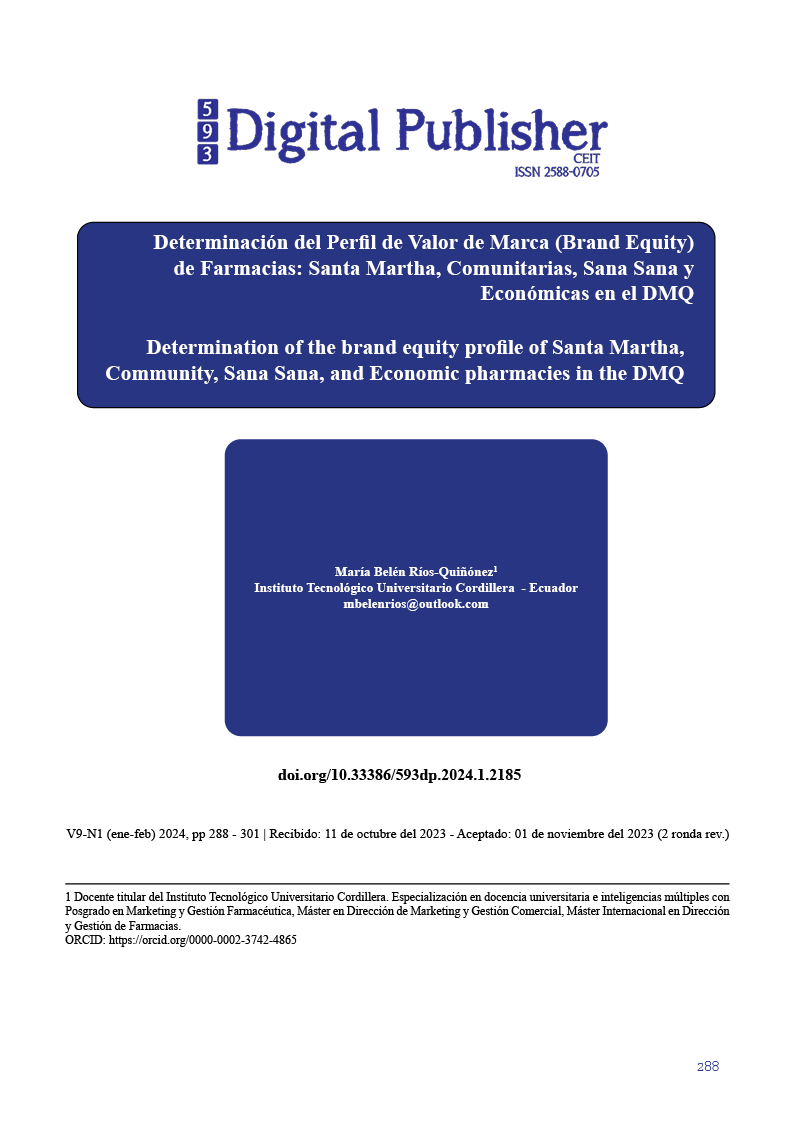Determination of the Brand Equity Profile of Santa Martha, Community, Sana Sana, and Economic Pharmacies in the DMQ
Main Article Content
Abstract
This research analyzed the value of the Santa Martha, Comunitarias, Sana Sana and Económicas pharmacy brands from the consumers' perspective through the identification of the main differentiation strategies of each one of them, in order to understand the relationship between brand preference and evaluation of the different attributes they present to their public, recognizing the attitudinal components of the value of pharmacy brands and detecting those that are considered direct competition. The research was descriptive, of transversal and bibliographic temporality, with qualitative and quantitative diagnosis of results obtained after the adaptation of the instrument: brand value based on the seven-component consumer (VMC7) developed by Dr. Jorge Vera Martínez. We worked with an intentional sample of 384 people over 18 years of age from the Metropolitan District of Quito. It was found that the most valuable components for each pharmacy are Sana Sana: "Satisfaction", Económicas "Perceived Quality", Comunitarias "Loyalty" and Santa Martha "Value of Use". It was verified that there are direct competitors: Sana Sana - Económicas and Comunitarias - Santa Martha. In the end, Sana Sana is the brand with the highest value, followed by Económicas, then by Comunitarias and, lastly, Santa Martha, which is the great surprise of recent years. The attributes, components, and reagents of a brand at the pharmaceutical level must be analyzed from various perspectives, since providing a quality pharmaceutical service with warmth requires optimal planning and management that considers all the customer's needs.
Downloads
Article Details

This work is licensed under a Creative Commons Attribution-NonCommercial-ShareAlike 4.0 International License.
1. Derechos de autor
Las obras que se publican en 593 Digital Publisher CEIT están sujetas a los siguientes términos:
1.1. 593 Digital Publisher CEIT, conserva los derechos patrimoniales (copyright) de las obras publicadas, favorece y permite la reutilización de las mismas bajo la licencia Licencia Creative Commons 4.0 de Reconocimiento-NoComercial-CompartirIgual 4.0, por lo cual se pueden copiar, usar, difundir, transmitir y exponer públicamente, siempre que:
1.1.a. Se cite la autoría y fuente original de su publicación (revista, editorial, URL).
1.1.b. No se usen para fines comerciales u onerosos.
1.1.c. Se mencione la existencia y especificaciones de esta licencia de uso.
References
Aaker, D. (1995). Building Strong Brands. New York: The Free Press.
Agencia Nacional de Regulación, Control y Vigilancia Sanitaria [ARCSA]. (enero de 2021). Control Sanitario. Obtenido de (Agencia Nacional de Regulación Control y Vigilancia Sanitaria - ARCSA, 2021)
Buil, I., De Chernatony, L., & Martínez, E. (2013). La importancia de medir el valor de marca desde la perspectiva del consumidor: Evidencia empírica en España y el Reino Unido. Revista de Ciencias Sociales, XIX (2), 226-237. doi:ISSN: 1315-9518
Datosmacro. (2020). Expansión.Datosmacro.com. Obtenido de https://datosmacro.expansion.com/demografia/poblacion/ecuador
Espósito, I. (2001). “Brand Equity: Modelos de Valuación”. Buenos Aires: Universidad del CEMA.
Hoyos Ballesteros, R. (2016). Branding: el arte de marcar corazones. Bogotá: Ecoe Ediciones.
ILGO. (2019). Como crear una marca.
Kotler, P., & Keller, K. (2012). Dirección de Marketing. México: Pearson.
Leuthesser, L. (1988). Defining, Measuring and Managing Brand Equity. Marketing Science Institute.
Municipio de Quito. (2022). Municipio de Quito, sitio oficial. Obtenido de Administraciones Zonales: https://www.quito.gob.ec/
Núñez Barriopedro, E., Cuesta Valiño, P., & Gutiérrez Rodríguez, P. (2012). Posicionamiento del valor de marca de firmas de moda. aDResearchESIC, 7(7), 08-19.
Ortíz - Prado, E., Galarza, C., Cornejo León, F., & Ponce, J. (2014). Acceso a medicamentos y situación del mercado farmacéutico en Ecuador. Rev Panam Salud Pública, 1, 57-62. Obtenido de https://www.scielosp.org/pdf/rpsp/2014.v36n1/57-62/es
Plan V. (5 de agosto de 2019). Plan V. Obtenido de El mercado farmacéutico en el Ecuador es caótico y concentrado: https://www.planv.com.ec/historias/sociedad/el-mercado-farmaceutico-el-ecuador-caotico-y-concentrado
Rust, R., Zeithaml, V., & Lemon, K. (2004). Gestión de marca centrada en el cliente. Harvard Business Review. Harvard Business Review, 82(9), 114-122.
Sana Sana. (2022). Sana Sana sitio web oficial. Obtenido de https://www.sanasana.com.ec/sanasana/quienes-somos
Sirlin, L. (2017). Estrategia para relanzar un simulador de negocios en un nuevo mercado. Palermo: Universidad de Palermo.
Vera Martínez, J. (2008). Perfil de valor de marca y las mediciones de sus componentes. Academia. Revista Latinoamericana de Administración (41), 69-89. doi: https://www.redalyc.org/articulo.oa?id=71611842007
Wilensky, A. (2010). Clases a toda hora. Obtenido de https://www.clasesatodahora.com.ar/examenes/uces/publicidad/practicaprof/practicaprof2010reswilensky.pdf
Yungán, A., & Urrutia Guevara, J. (2015). Plan de publicidad y promoción y el incremento del posicionamiento de la marca para la cadena de farmacias Pichincha de la ciudad de Ambato, provincia de Tungurahua. Ambato: UNIANDES.


